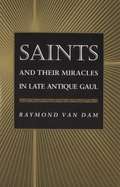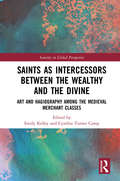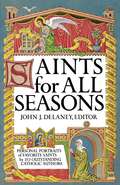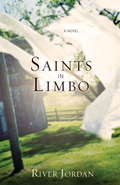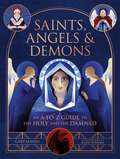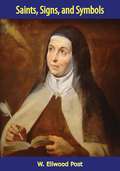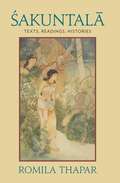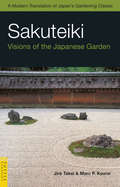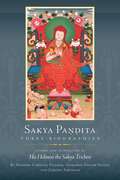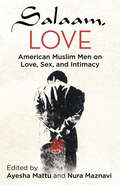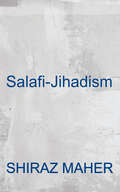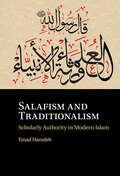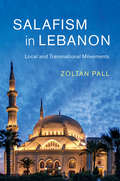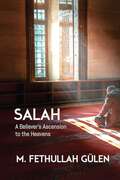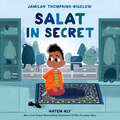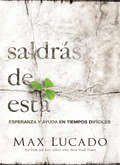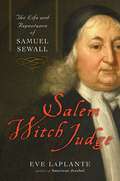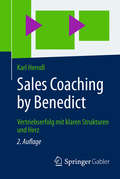- Table View
- List View
Saints and Their Miracles in Late Antique Gaul
by Raymond Van DamSaints' cults, with their focus on miraculous healings and pilgrimages, were not only a distinctive feature of Christian religion in fifth-and sixth-century Gaul but also a vital force in political and social life. Here Raymond Van Dam uses accounts of miracles performed by SS. Martin, Julian, and Hilary to provide a vivid and comprehensive depiction of some of the most influential saints' cults. Viewed within the context of ongoing tensions between paganism and Christianity and between Frankish kings and bishops, these cults tell much about the struggle for authority, the forming of communities, and the concept of sin and redemption in late Roman Gaul.Van Dam begins by describing the origins of the three cults, and discusses the career of Bishop Gregory of Tours, who benefited from the support of various patron saints and in turn promoted their cults. He then treats the political and religious dimensions of healing miracles--including their relation to Catholic theology and their use by bishops to challenge royal authority--and of pilgrimages to saints' shrines. The miracle stories, collected mainly by Gregory of Tours, appear in their first complete English translations.
Saints as Intercessors between the Wealthy and the Divine: Art and Hagiography among the Medieval Merchant Classes (Sanctity in Global Perspective)
by Emily Kelley Cynthia Turner CampOffering snapshots of mercantile devotion to saints in different regions, this volume is the first to ask explicitly how merchants invoked saints, and why. Despite medieval and modern stereotypes of merchants as godless and avaricious, medieval traders were highly devout – and rightly so. Overseas trade was dangerous, and merchants’ commercial activities were seen as jeopardizing their souls. Merchants turned to saints for protection and succor, identifying those most likely to preserve their goods, families, reputations, and souls. The essays in this collection, written from diverse angles, range across later medieval western Europe, from Spain to Italy to England and the Hanseatic League. They offer a multi-disciplinary examination of the ways that medieval merchants, from petty traders to influential overseas wholesalers, deployed the cults of saints. Three primary themes are addressed: danger, community, and the unity of spiritual and cultural capital. Each of these themes allows the international panel of contributors to demonstrate the significant role of saints in mercantile life. This book is unique in its exploration of saints and commerce, shedding light on the everyday role religion played in medieval life. As such, it will be of keen interest to scholars of religious history, medieval history, art history, and literature.
Saints for All Seasons
by John J. DelaneyPersonal portraits of favorite saints by 20 outstanding Catholic authors
Saints in Limbo
by River Jordan"River Jordan's Saints in Limbo is a compelling story of the mysteries of existence and, specially, the mysteries of the human heart."-Ron Rash, author of Serena and Chemistry and Other Stories"I lose myself in River's writing-transported to a different time and place- and in this case, to one that makes the ordinary mystical and magical. I give it FIVE diamonds in the Pulpwood Queen's TIARA!"-Kathy L. Patrick, founder of the Pulpwood Queens Book Clubs and author of The Pulpwood Queens' Tiara Wearing, Book Sharing Guide to LifeEver since her husband Joe died, Velma True's world has been limited to what she can see while clinging to one of the multicolored threads tied to the porch railing of her home outside Echo, Florida.When a mysterious stranger appears at her door on her birthday and presents Velma with a special gift, she is rattled by the object's ability to take her into her memories-a place where Joe still lives, her son Rudy is still young, unaffected by the world's hardness, and the beginning is closer than the end. As secrets old and new come to light, Velma wonders if it's possible to be unmoored from the past's deep roots and find a reason to hope again. Praise for River Jordan"[River Jordan's] literary spice rack has everything you need to put together a good book."-Rick Bragg, author of All Over but the Shoutin' and Ava's Man"River Jordan writes so beautifully." -Joshilyn Jackson, author of Gods in Alabama and The Girl Who Stopped SwimmingFrom the Trade Paperback edition.
Saints, Angels & Demons: An A-to-Z Guide to the Holy and the Damned
by Gary JansenSaints, Angels, and Demons is an illustrated compendium of the fascinating lives and meaningful legacies of nearly 400 iconic figures who have influenced history, religion, literature, and art, throughout the centuries and across the world. From St. Augustine, whose writings helped shape Western culture to St. Bernadette, whose visions of Mary led to decades of holy pilgrimages by the faithful, and from Archangel Michael, defender of good in the face of evil to Asmodeus, the three-headed demon of lust, temptation, and destruction, the history of the saints and spiritual creatures is, in many respects, the history of the world. Award-winning author Gary Jansen weaves together the lives of the holy (and not-so-holy) beings who have graced and defiled our earthly realm from the first century BC to the present day. Organized alphabetically, the book provides lyrical capsule histories of nearly 400 figures describing their lives and the details of their most important contributions to the world. Each entry is accompanied by key information such as the associated signs and symbols, patronage, and feast days. A glossary and numerous appendices providing historical and religious context. For the faithful and the intellectually curious alike, Saints, Angels, and Demons is an essential reference and a comprehensive overview of the history of humanity, as told through a unique perspective.
Saints, Signs, and Symbols: The Symbolic Language Of Christian Art
by W. PostSaints, Signs, and Symbols, which was first published in 1962, contains in compact form all the main symbols used in the Church, complete with notes on their origin, meaning, and colouring. Of particular interest is the section on the Saints, which includes brief biographical details of each.“This is an indispensable handbook for teaching at all age levels.”—Kirkus Review
Saints: Faith without Borders
by Francoise Meltzer Jas ElsnerWhile the modern world has largely dismissed the figure of the saint as a throwback, we remain fascinated by excess, marginality, transgression, and porous subjectivity--categories that define the saint. In this collection, Françoise Meltzer and Jas Elsner bring together top scholars from across the humanities to reconsider our denial of saintliness and examine how modernity returns to the lure of saintly grace, energy, and charisma. Addressing such problems as how saints are made, the use of saints by political and secular orders, and how holiness is personified, Saints takes us on a photo tour of Graceland and the cult of Elvis and explores the changing political takes on Joan of Arc in France. It shows us the self-fashioning of culture through the reevaluation of saints in late-antique Judaism and Counter-Reformation Rome, and it questions the political intent of underlying claims to spiritual attainment of a Muslim sheikh in Morocco and of Sephardism in Israel. Populated with the likes of Francis of Assisi, Teresa of Avila, and Padre Pio, this book is a fascinating inquiry into the status of saints in the modern world.
Saints: Faith without Borders (A\critical Inquiry Book Ser.)
by Francoise Meltzer and Jas ElsnerWhile the modern world has largely dismissed the figure of the saint as a throwback, we remain fascinated by excess, marginality, transgression, and porous subjectivity—categories that define the saint. In this collection, Françoise Meltzer and Jas Elsner bring together top scholars from across the humanities to reconsider our denial of saintliness and examine how modernity returns to the lure of saintly grace, energy, and charisma.Addressing such problems as how saints are made, the use of saints by political and secular orders, and how holiness is personified, Saints takes us on a photo tour of Graceland and the cult of Elvis and explores the changing political takes on Joan of Arc in France. It shows us the self-fashioning of culture through the reevaluation of saints in late-antique Judaism and Counter-Reformation Rome, and it questions the political intent of underlying claims to spiritual attainment of a Muslim sheikh in Morocco and of Sephardism in Israel. Populated with the likes of Francis of Assisi, Teresa of Avila, and Padre Pio, this book is a fascinating inquiry into the status of saints in the modern world.
Sakuntala: Texts, Readings, Histories (Anthem South Asian Studies)
by Romila ThaparThe figure of Sakuntala appears in many forms throughout South Asian literature, most famously in the Mahabharata and in Kalidisa's fourth-century Sanskrit play, Sakuntala and the Ring of Recollection. In these two texts, Sakuntala undergoes a critical transformation, relinquishing her assertiveness and autonomy to become the quintessentially submissive woman, revealing much about the performance of Hindu femininity that would come to dominate South Asian culture. Through a careful analysis of sections from Sakuntala and their various iterations in different contexts, Romila Thapar explores the interactions between literature and history, culture and gender, that frame the development of this canonical figure, as well as a distinct conception of female identity.
Sakuteiki
by Marc P. Keane Jiro TakeiThe Sakuteiki, or "Records of Garden Making," was written nearly one thousand years ago. It is the oldest existing text on Japanese gardening-or any kind of gardening—in the world. In this edition of the Sakuteiki the authors provide both an English-language translation of this classic work and an introduction to the cultural and historical context that led to the development of Japanese gardening.
Sakya Pandita: Three Biographies
by Drogon Chogyal PhakpaA set of classic biographies of Sakya Pandita—one of Tibet&’s greatest scholars and religious masters.Sakya Pandita Kunga Gyaltsen (1182–1251) was a renowned Tibetan polymath, scholar, statesman, and religious master, and remains one of the most famous and consequential figures in the history of Tibet. The three biographies included here contain fascinating firsthand accounts of key events in Sakya Pandita's life, covering his family ancestry, early education, interactions and ddebates with other sects, and travels to Mongolia and his diplomacy at the Mongol court, as well as a detailed account of the miraculous events that occurred in the last weeks of his life. These were written by three central figures of the Sakya tradition: Drogon Chogyal Phakpa (Lodro Gyaltsen) (1235–80), who was Sakya Pandita's nephew and religious successor; Gorampa Sonam Senge (1429–89), a renowned Sakya scholar and prolific author who served as the sixth abbot of Ngor Monastery; and Jamgon Ameshab (Ngawang Kunga Sonam) (1597–1659), who was the twenty-seventh throne holder of the Sakya order and one of the foremost Tibetan literary and historical scholars of his time. The translations demonstrate the unique compositional style of traditional Tibetan religious biography and contain many fascinating first-person accounts of what it was like to spend time in the presence of a great Buddhist master and statesman who lived one thousand years ago in the midst of one of Asia's most tumultuous periods.
Sakya: Essential Teachings of the Eight Practice Lineages of Tibet, Volume 5 (The Treasury of Precious Instructions) (The Treasury of Precious Instructions)
by Jamgön Kongtrul ThayéA compilation by one of Tibet's greatest Buddhist masters of the Path with Its Result teachings and practices of the Sakya lineage of Tibetan Buddhism.The Treasury of Precious Instructions by Jamgön Kongtrul Lodrö Taye, one of Tibet's greatest Buddhist masters, is a shining jewel of Tibetan literature, presenting essential teachings from the entire spectrum of practice lineages that existed in Tibet. Volumes in this series may be engaged as practice manuals while also preserving ancient teachings significant to the literature and history of world religions. Volume 5 of the series, Sakya: The Path with Its Result, presents a selection of teachings and practices from the Path with Its Result (Lamdre) practice lineage of the Sakya tradition of Tibetan Buddhism. The Sakya lineage derives from Virupa, Dombhi Heruka, and other Indian masters, or mahasiddhas, and passes through Gayadhara and his Tibetan disciple Drokmi Lotsawa Sakya Yeshe (992–1072). The practice tradition centers around the teaching and transmission of the Hevajra Tantra and its subsidiary texts. In three parts, this volume includes, respectively: the root text, commentary, and outlines for the Indian mahasiddha Virupa&’s core text, the Vajra Verses; the liturgies for empowerment and offering rituals specific to a Hevajra Tantra practice lineage; and instructional manuals for practice.
Sakya: Essential Teachings of the Eight Practice Lineages of Tibet, Volume 6 (The Treasury of Precious Instructions) (The Treasury of Precious Instructions)
by Jamgon Kongtrul Lodro TayeA collection of liturgical and instructional practice texts on the Eight Ancillary Path Cycles of the Sakya lineage of Tibetan Buddhism, compiled by one of Tibet's greatest Buddhist masters.The Treasury of Precious Instructions by Jamgön Kongtrul Lodrö Taye, one of Tibet's greatest Buddhist masters, is a shining jewel of Tibetan literature, presenting essential teachings from the entire spectrum of practice lineages that existed in Tibet. In its eighteen volumes, Kongtrul brings together some of the most important texts on key topics of Buddhist thought and practice as well as authoring significant new sections of his own. Volumes in this series may be engaged as practice manuals while also preserving ancient teachings significant to the literature and history of world religions. Volume 6 of the series, Sakya: The Path with Its Result, Part Two, presents a selection of teachings and practices from the Eight Ancillary Path Cycles of the Sakya tradition of Tibetan Buddhism. The Sakya lineage derives from Virūpa, Dombi Heruka, and other Indian masters, or mahāsiddhas, and passes through Gayadhara and his Tibetan disciple Drokmi Lotsāwa Śākya Yeshe (992–1072). The practice tradition centers around the teaching and transmission of the Hevajra Tantra and its subsidiary texts. This second volume of Sakya texts contains oral instructions transmitted to Drokmi Lotsāwa by the early eleventh-century Indian masters, Ācārya Vīravajra, Mahāsiddha Amoghavajra, Paṇḍita Prajñāgupta of Oḍḍiyāna, and Paṇḍita Gayadhara. These texts broaden our understanding of how mahāmudrā, the teaching on the nature of mind, is understood and practiced in the Sakya school.
Salaam, Love: American Muslim Men on Love, Sex, and Intimacy
by Ayesha Mattu Nura MaznaviFrom the editors of the groundbreaking anthology Love, InshAllah comes a provocative new exploration of the most intimate parts of Muslim men's lives. Muslim men are stereotyped as either oversexed Casanovas willing to die for seventy-two virgins in heaven or controlling, big-bearded husbands ready to rampage at the hint of dishonor. The truth is, there are millions of Muslim men trying to figure out the complicated terrain of love, sex, and relationships just like any other American man. In Salaam, Love, Ayesha Mattu and Nura Maznavi provide a space for American Muslim men to speak openly about their romantic lives, offering frank, funny, and insightful glimpses into their hearts--and bedrooms. The twenty-two writers come from a broad spectrum of ethnic, racial, and religious perspectives--including orthodox, cultural, and secular Muslims--reflecting the strength and diversity of their faith community and of America. By raising their voices to share stories of love and heartbreak, loyalty and betrayal, intimacy and insecurity, these Muslim men are leading the way for all men to recognize that being open and honest about their feelings is not only okay--it's intimately connected to their lives and critical to their happiness and well-being.
Salafi-jihadism: The History Of An Idea
by Shiraz MaherNo topic has captured the public imagination of late quite so dramatically as the specter of global jihadism. While much has been said about the way jihadists behave, their ideology remains poorly understood. As the Levant has imploded and millenarian radicals claim to have revived a Caliphate based on the teachings of the Prophet Mohammed, the need for a nuanced and accurate understanding of jihadist beliefs has never been greater. Shiraz Maher charts the intellectual underpinnings of salafi-jihadism from its origins in the mountains of the Hindu Kush to the jihadist insurgencies of the 1990s and the 9/11 wars. What emerges is the story of a pragmatic but resilient warrior doctrine that often struggles - as so many utopian ideologies do - to consolidate the idealism of theory with the reality of practice.
Salafism and Traditionalism: Scholarly Authority in Modern Islam
by Emad HamdehOne of the most contentious topics in modern Islam is whether one should adhere to an Islamic legal school or follow scripture directly. For centuries, Sunni Muslims have practiced Islam through the framework of the four legal schools. The 20th century, however, witnessed the rise of individuals who denounced the legal schools, highlighting cases where they contradict texts from the Qur'ān or Sunna. These differences are exemplified in the heated debates between the Salafi ḥadīth scholar Muḥammad Nāṣir al-Dīn al-Albānī and his Traditionalist critics. This book examines the tensions between Salafis and Traditionalists concerning scholarly authority in Islam. Emad Hamdeh offers an insider's view of the debates between Salafis and Traditionalists and their differences regarding the correct method of interpreting Islam. He provides a detailed analysis of the rise of Salafism, the impact of the printing press, the role of scholars in textual interpretation, and the divergent approaches to Islamic law.
Salafism in Jordan
by Joas WagemakersSince the events of 9/11, Salafism in the Middle East has often been perceived as fixed, rigid and even violent, but this assumption overlooks the quietist ideology that characterises many Salafi movements. Through an exploration of Salafism in Jordan, Joas Wagemakers presents the diversity among quietist Salafis on a range of ideological and political issues, particularly their relationship with the state. He expounds a detailed analysis of Salafism as a whole, whilst also showing how and why quietist Salafism in Jordan - through ideological tendencies, foreign developments, internal conflicts, regime involvement, theological challenges and regional turmoil - transformed from an independent movement into a politically domesticated one. Essential for graduate students and academic researchers interested in Middle Eastern politics and Salafism, this major contribution to the study of Salafism debunks stereotypes and offers insight into the development of a trend that still remains a mystery to many.
Salafism in Lebanon: Local And Transnational Movements (Cambridge Middle East Studies #49)
by Zoltan PallThe past two decades have seen an increasing association between Lebanese Salafism and violence, with less attention being paid to Salafis who focus on peaceful proselytization. In reality, it is these Salafis whose influence has dramatically grown since the eruption of the Syrian conflict that profoundly affected Lebanon as well. <P><P>Based on extensive fieldwork, Zoltan Pall offers insights into the dynamics of non-violent Lebanese Salafi groups and examines the importance of transnational links in shaping the trajectory of the movement. In particular, he shows how the internal transformation of Salafism in Kuwait, Qatar and Saudi Arabia led to the fragmentation of the Lebanese Salafi community. <P>By analysing Salafism as a network, we see how the movement creates and mobilizes material and symbolic resources, and how it contributes to reshaping the structures of authority within the country's Sunni Muslim community.
Salafismus
by Rauf Ceylan Michael KieferNeo-Salafistische Gruppierungen haben in den letzten Jahren die Diskussionen über den Islam in Deutschland stark geprägt. Trotz der religionspädagogischen und integrationspolitischen Relevanz fehlen weitgehend Erfahrungen mit Präventionsmaßnahmen gegen diese Strömung. Vor diesem Hintergrund verfolgt der vorliegende Band das Ziel, einen kompakten Überblick über die historischen Wurzeln und die politisch-theologischen Ideologien dieser fundamentalistischen Bewegungen zu geben. Als zweiter Themenschwerpunkt werden spezifische Präventionsmaßnahmen für den islamischen Religionsunterricht, für die Jugend- und Gemeindearbeit vorgestellt und kritisch eingeordnet sowie auf die Defizite in den unterschiedlichen Handlungsfeldern einer Präventionsarbeit hingewiesen.
Salafismus in Deutschland: Jugendkulturelle Aspekte, pädagogische Perspektiven (Edition Centaurus – Jugend, Migration und Diversity)
by Ahmet Toprak Gerrit WeitzelDer Band untersucht den Salafismus als Phänomen einer spezifischen Jugendkultur - die nicht nur auf Jugendliche mit Migrationshintergrund zielt und befasst sich mit ihrer Attraktivität sowie ihrer medialen und subkulturellen Mustern.
Salah: A Believer's Ascension to the Heavens
by Fethullah GulenPrayer is an essential part of a Muslim&’s life. While a believer can pray and offer their devotions any time and any where they like, Islamic tradition prescribes a specific form of prayers to be performed at five different times of the day. It is a celebratory act of submission in which believers align themselves with all other creation by offering their praise and gratitude to God, the Merciful, the Compassionate, as they stand, bow, and prostrate in propriety. These daily prayers are called salah, and this book is an all-comprehensive exploration of this spiritual act by one of the leading Muslim scholars of our time. The focus in this book is more on the spiritual aspect of salah, rather than its formulaic details which can be easily found in countless other manuals.
Salat in Secret
by Jamilah Thompkins-BigelowFrom the critically acclaimed author of Your Name Is a Song and the bestselling illustrator of The Proudest Blue comes a story about a Muslim boy who receives a salat (prayer) rug on his seventh birthday and becomes empowered about his faith.In this beautiful story of community, family, and acceptance, a boy named Muhammad receives a special salat rug on his seventh birthday. Seven is the age when Muslim children are encouraged to pray, and Muhammad is determined to do all five daily prayers on time. But one salat occurs during the school day--and he's worried about being seen praying at school. His father parks his truck to worship in public places, and people stare at and mock him. Will the same thing happen to Muhammad?In the end, with help from his teacher, he finds the perfect place to pray. Salat in Secret, by two highly acclaimed Muslim creators, is a poignant and empowering look at an important facet of Islam that many observant children cherish but might be scared to share.
Saldrás de esta
by Max LucadoNo será sin dolor. No será de un día para otro. Pero Dios usará este lío para bien.Mientras tanto, mantén la calma y no hagas ninguna tontería.No te desesperes.Con la ayuda de Dios, saldrás de esta.Tienes temor de no lograrlo. Todos le tememos a eso. Tememos que la depresión nunca se vaya, que los gritos nunca cesen, que el dolor no nos deje. ¿Se aclarará este cielo gris? ¿Se alivianará esta carga?En Saldrás de esta, el pastor Max Lucado, uno de los autores más leídos según el New York Times, ofrece una dulce seguridad. "La liberación es a la Biblia lo que la música es a época de carnaval: audaz, abrasadora y está en todas partes". Max les recuerda a los lectores que Dios no promete que salgamos de las pruebas rápidamente y sin dolor. No fue así para José --lanzado a una fosa por sus hermanos, vendido como esclavo, arrestado injustamente, olvidado y rechazado-- pero su historia en el Antiguo Testamento está en la Biblia por esta razón: para enseñarnos a confiar que Dios triunfará sobre el mal.Con la compasión de un pastor y el alma de un narrador de cuentos, Max explora la historia de José y la verdad del Génesis 50:20. Lo que Satanás intenta para mal, Dios lo redime para bien.
Salem Witch Judge: The Life and Repentance of Samuel Sewall
by Eve LaPlanteIn 1692 Puritan Samuel Sewall sent twenty people to their deaths on trumped-up witchcraft charges. The nefarious witch trials in Salem, Massachusetts represent a low point of American history, made famous in works by Longfellow, Nathaniel Hawthorne (himself a descendant of one of the judges), and Arthur Miller. The trials might have doomed Sewall to infamy except for a courageous act of contrition now commemorated in a mural that hangs beneath the golden dome of the Massachusetts State House picturing Sewall's public repentance. He was the only Salem witch judge to make amends.But, remarkably, the judge's story didn't end there. Once he realized his error, Sewall turned his attention to other pressing social issues. Struck by the injustice of the New England slave trade, a commerce in which his own relatives and neighbors were engaged, he authored "The Selling of Joseph," America's first antislavery tract. While his peers viewed Native Americans as savages, Sewall advocated for their essential rights and encouraged their education, even paying for several Indian youths to attend Harvard College. Finally, at a time when women were universally considered inferior to men, Sewall published an essay affirming the fundamental equality of the sexes. The text of that essay, composed at the deathbed of his daughter Hannah, is republished here for the first time.In Salem Witch Judge, acclaimed biographer Eve LaPlante, Sewall's great-great-great-great-great-great-granddaughter, draws on family lore, her ancestor's personal diaries, and archival documents to open a window onto life in colonial America, painting a portrait of a man traditionally vilified, but who was in fact an innovator and forefather who came to represent the best of the American spirit.
Sales Coaching by Benedict
by Karl HerndlWer Ordnung hat, hat auch Erfolg. Klare Strukturen und ganzheitliche Organisation gepaart mit Menschlichkeit dienen der Bündelung der Kräfte - und damit der nachhaltigen Zielerreichung. Nach diesen Grundsätzen lebt der Benediktinerorden seit vielen Jahrhunderten. Doch die Benediktsregel hat nicht nur im Kloster ihren Platz. Sie kann ebenso für die Optimierung von Vertriebsprozessen angewandt werden - und liefert überraschende Ergebnisse. Wie das gelingt, wird in diesem Buch deutlich. Der Autor Karl Herndl überträgt die Grundkonstanten der Benediktsregel auf den Vertrieb und gibt direkt umsetzbare Antworten auf konkrete Fragestellungen: Wie entwickelt man eine Ordnung, in der Umsätze langfristig wachsen? Wie schaffen Führungskräfte eine Kultur der gegenseitigen Wertschätzung? Welche Konstanten sind für erfolgreiche Verkaufs- und Führungsgespräche notwendig? Als Fallbeispiel dient der Coaching-Prozess eines renommierten Versicherungsunternehmens, das vom Autor erfolgreich betreut wurde. Die hier eingeführte ,,Sales-Ordnung" kann auf alle Branchen übertragen werden kann. ,,Herndl ordnet den Tagesablauf der Verkäufer und Führungskräfte im Vertrieb, schafft eine Kultur der gegenseitigen Wertschätzung und gleichzeitig ein verlässliches Erreichen der vereinbarten Vertriebsergebnisse. " Dr. Notker Wolf, Abtprimas des Benediktinerordens ,,Karl Herndl zeigt Führungskräften, WIE man führt. Ganzheitliches Denken und Organisieren und dies mit der Fokussierung auf die Grundlagen und das Tun, das macht die Botschaften dieses Buches wertvoll. " Michael Rentmeister, CEO, OVB Holding AG
